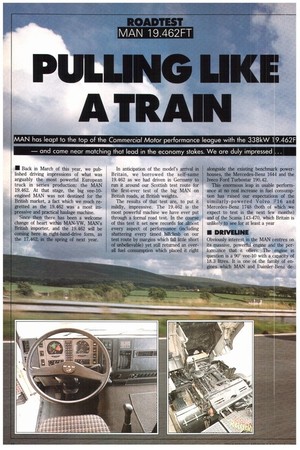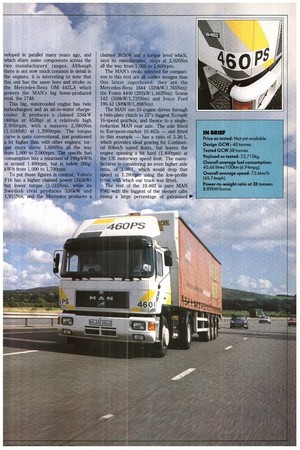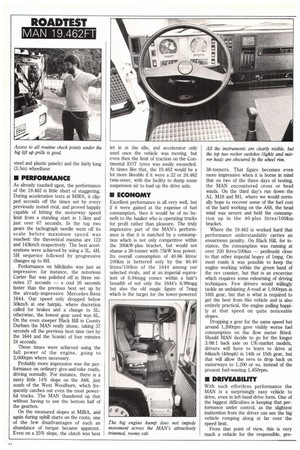PUN A TRAIN
Page 40

Page 41

Page 42

Page 43

If you've noticed an error in this article please click here to report it so we can fix it.
MAN has leapt to the top of the Commercial Motor performance league with the 38kW
— and came near matching that lead in the economy stakes. We are duly impressed
• Back in March of this year, we published driving impressions of what was arguably the most powerful European truck in series production: the MAN 19.462. At that stage, the big vee-10engined MAN was not destined for the British market, a fact which we much regretted as the 19.462 was a most impressive and practical haulage machine.
Since then there has been a welcome change of heart within MAN-VW, MAN's British importer, and the 19.462 will be coming here in right-hand-drive form, as the 17.462, in the spring of next year. In anticipation of the model's arrival in Britain, we borrowed the self-same 19.462 as we had driven in Germany to run it around our Scottish test route for the first-ever test of the big MAN on British roads, at British weights.
The results of that test are, to put it mildly, impressive. The 19.462 is the most powerful machine we have ever put through a formal road test. In the course of this test it set new records for almost every aspect of performance (including shattering every timed hillclimb on our test route by margins which fall little short of unbelievable) yet still returned an overall fuel consumption which placed it right alongside the existing benchmark powerhouses, the Mercedes-Benz 1644 and the Iveco Ford Turbostar 190.42.
This enormous leap in usable performance at no real increase in fuel consumption has raised our expectations of the similarly-powered Volvo :F16 and Mercedes-Benz 1748 (both of which we expect to test in the next few months) and of the Scania 143-470, which Britain is unlikely to see for at least a year
• DRIVEUNE
Obviously interest in the MAN centres on its massive, powerful engine and the performance that it offers. The engine in question is a 90° vee-10 with a capacity of 18.3 litres. It is one of the family of engines which MAN and Daimler-Benz de veloped in parallel many years ago, and which share some components across the two manufacturers ranges. Although there is not now much common in detail in the engines, it is interesting to note that this unit has the same bore and stroke as the Mercedes-Benz OM 442LA which powers the MAN's big home-produced rival, the 1748.
This big, watercooled engine has twin turbochargers and an air-to-water chargecooler. It produces a claimed 338kW (460ps or 453hp) at a relatively high 2.000rpm, with a massive 2,080Nm (1.534Ibft) at I,2000rpm. The torque curve is quite conventional, just positioned a lot higher than with other engines: torque stays above 1,600Nm all the way from 1,000 to 2.000rpm. The specific fuel consumption hits a minimum of 194g/kW/h at around 1.400rpm, but is below 200g/ kW/h from 1,000 to 1,700rpm.
To put those figures in context, Volvo's F16 has a higher claimed power (342kW) but lower torque (2.015Nm), while its Swedish rival produces 336kW and 1,915Nm, and the Mercedes produces a claimed 362kW and a torque level which, says its manufacturer, stays at 2,020Nm all the way from 1,000 to I,600rpm.
The MAN's rivals selected for comparison in this test are all earlier designs than this latest superbreed: they are the Mercedes-Benz 1644 (320kW/1,765Nm); the Foden 4400 (291kW/1,463Nm); Scania 142 (309kW/1,725Nm) and Iveco Ford 190.42 (309kW/1,898Nm).
The MAN vee-10 engine drives through a twin-plate clutch to ZF's biggest Ecosplit 16-speed gearbox, and thence to a singlereduction MAN rear axle. The axle fitted to European-market 19.462s — and fitted to this example — has a ratio of 3.36:1, which provides ideal gearing for Continental 80km/h speed limits, but leaves the engine spinning a bit hard (1,400rpm) at the UK motorway speed limit. The manufacturer is considering an even higher axle ratio, of 3.08:1, which would drop that speed to 1.280r13rn using the low-profile tyres with which our truck was fitted.
The rest of the 19.462 is pure MAN F90, with the biggest of the sleeper cabs (using a large percentage of galvanised IP' steel and plastic panels) and the fairly long (3.5m) wheelbase
• PERFORMANCE
As already touched upon, the performance of the 19.462 is little short of staggering. During acceleration tests at MIRA, it clipped seconds off the times set by every previously tested rival, and proved happily capable of hitting the motorway speed limit from a standing start in 1.5km and just over 67 seconds. In the top two gears the tachograph needle went off its scale before maximum speed was reached: the theoretical maxima are 122 and 143km/h respectively. The best accelerations were achieved by using a 3L, 4H, 511 sequence followed by progressive changes up to 8H.
Performance on hiliclimbs was just as impressive: for instance, the notorious Carter Bar was polished off in three minutes 27 seconds — a cool 26 seconds faster than the previous best set up by the already-impressive Mercedes-Benz 1644. Our speed only dropped below 50km/h at one hairpin, where discretion called for brakes and a change to 5L: otherwise, the lowest gear used was 6L. On the even steeper Black Hill in County Durham the MAN really shone, taking 37 seconds off the previous best time (set by the 1644 and the Scania) of four minutes 24 seconds.
Those times were achieved using the full power of the engine, going to 2,000rpm where necessary.
Probably more impressive was the performance on ordinary give-and-take roads, driving normally. For instance, there is a nasty little 14% slope on the A68, just south of the West Woodburn, which frequently catches out even the most powerful trucks. The MAN thundered up that without having to use the bottom half of the gearbox.
On the measured slopes at MIRA, and again during uphill starts on the route, one of the few disadvantages of such an abundance of torque became apparent. Even on a 25% slope, the clutch was best et in at the idle, and accelerator only used once the vehicle was moving, but even then the limit of traction on the Continental EOT tyres was easily exceeded. At times like that, the 19.462 would be a lot more likeable if it were a 22 or 24.462 twin-steer, with the facility to dump some suspension air to load up the drive axle.
• ECONOMY
Excellent performance is all very well, but if it were gained at the expense of fuel consumption, then it would be of no benefit to the haulier who is operating trucks for profit rather than pleasure. The truly impressive part of the MAN's performance is that it is matched by a consumption which is not only competitive within the 300kW-plus bracket, but would not shame a 38-tonner with 75kW less power. Its overall consumption of 40.66 litres/ 100km is bettered only by the 40.40 litres/100km of the 1644 among our selected rivals, and at an imperial equivalent of 6.94mpg comes within a hair's breadth of not only the 1644's 6.99mpg but also the old magic figure of 7mpg which is the target for the lower-powered 38-tonners. That figure becomes even more impressive when it is borne in mind that on two of the three days of testing, the MAN encountered cross or head winds. On the third day's run down the Al, M18 and MI, where we would normally hope to recover some of the fuel cost of the hard working on the A68, the head wind was severe and held the consumption up in the 40-plus litres/100km bracket.
Where the 19.462 is worked hard that performance understandably carries an enourmous penalty. On Black Hill, for instance, the consumption was running at over 250 litres/100km — perilously close to that other imperial bogey of lmpg. On most roads it was possible to keep the engine working within the green band of the rev counter, but that is an excercise which requires some relearning of driving techniques. Few drivers would willingly tackle an undulating A-road at 1,000rpm in 16th gear, but that is what is required to get the best from this vehicle and is also entirely practical, the engine pulling happily at that speed on quite noticeable slopes.
Dropping a gear for the same speed but around 1,200rpm gave visibly worse fuel consumption on the flow meter fitted. Should MAN decide to go for the longer 3.08:1 back axle on UK-market models, drivers will have to learn to drive at 64km/h (40mph) in 14th or 15th gear, but that will allow the revs to drop back on motorways to 1,200 or so, instead of the present fuel-wasting 1,450rpm.
• DRIVEABILITY
With such effortless performance the MAN is a surprisingly easy vehicle to drive, even in left-hand-drive form. One of the biggest difficulties is keeping that performance under control, as the slightest inattention from the driver can see the big vehicle romping along at far over the speed limit.
From that point of view, this is very much a vehicle for the responsible, pro fessional driver, and even then a speed limiter or cruise control would be a welcome addition and will certainly be fitted to the British-market model in line with established MAN policy.
As ever ZF's Ecosplit gearbox works well in a left-hand-drive environment where linkages fall naturally and even the much-maligned "double-H" shift mechanism is correctly weighted. The ratios are well spaced to match the characteristics of the big engine, shift loads are reasonable, and in any case the performance reduces gearshifting to a minimum.
The MAN chassis is well-balanced, giving good handling characteristics. One of the consequences, of an abundance of power is a tendency to understeer on winding hills, a trait easily overcome by lifting off — an unusual sensation for anybody used to having to keep the accelerator pedal floored to maintain progress.
• BRAKES
Any 38-tonner needs good brakes: a highpowered 38-tormer needs better brakes than most. The MAN has massive drums — with 220mm-wide linings at the rear — and is fitted with ABS. These brakes work very well, with a good hard pedal feel and no undue sensitivity. During brake tests at MIRA the vehicle pulled up all square, with no wheel lockup on the tractor unit. The actual peaks of deceleration were not notably high, at around 0.67g, but a sustained level of braking of over 0.4g is in line with the average for the class. The parking brake held well on a 25% slope.
The MAN also has a very good exhaust brake, with a button mounted in an easilyaccessed position on the floor. Some turbocharged engines suffer from poor exhaust brakes, but the sheer capacity of fly of this engine promised a good performance, and that promise is borne out with the exhaust brake having a noticeable effect at speeds as low as 1,200rprn. This allowed us to come down the south slope of Carter Bar, for instance, at around 601cm/h on the exhaust brake alone in 611 (12th), perfectly under control.
11 CAB COMFORT
The F90 series has won MAN a deserved reputation for roomy comfort and good ergonomics, and in this respect the 19.462 is little different from its smaller stablemates. The fully-adjustable steeing column and lsringhausen suspension seat combine to give a good driving position, and the ride over Scotland's bumpy roads was as good as any.
Access to and across the cab, even with the big engine hump, is good, and visibility is first-class except for the thickness of the quarter-window frame, which can intrude on the view of the outside mirrors, which are electrically-heated, but not electrically adjusted.
Wind noise is low, except that in cross winds the big visor over the front screen starts to make a low moaning noise. As we have remarked before, the MAN vee10 engine is notable for a lack of engine noise, especially when working hard. It is only when the driver's window is open that the full noise implications of having 340kW working hard are noticed.
The exterior noise is redolent of nothing so much as one of British Rail's big diesel-electric freight locomotives. Not only does the exhaust have a deep rumble, but asking for a lot of performance from low revs brings the same characteristic whistle of accelerating turbochargers followed by the individual beats of hardworking cylinders slowly building up speed. Any driver who likes big engines will be seduced by this wonderful sound, and is liable to drive with the window down whenever possible.
That said, the overall sound levels are no higher than from the other big-engined 38-tormers, and this vehicle is certainly quieter than any using the big 14-litre Cummins engine, for instance.
• SUMMARY
It is difficult not to be over-enthusiastic about the MAN 19.462. It is an impressive vehicle endowed with truly towering performance, yet capable of delivering that performance with no penalties in fuel consumption. It is a smooth and civilised performer, with no nasty characteristics and should, in the right hands, be an exceptionally productive workhorse.
It will never be a big seller — availability and a price certain to be on the wrong side of £60,000 will see to that — but those few who can justify its purchase will be lucky indeed. 0 by Allan Winn
















































